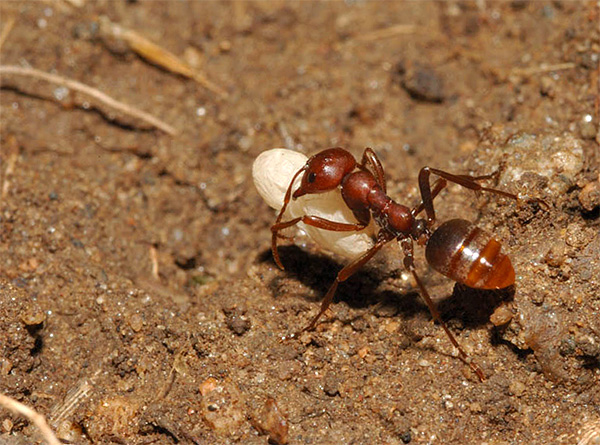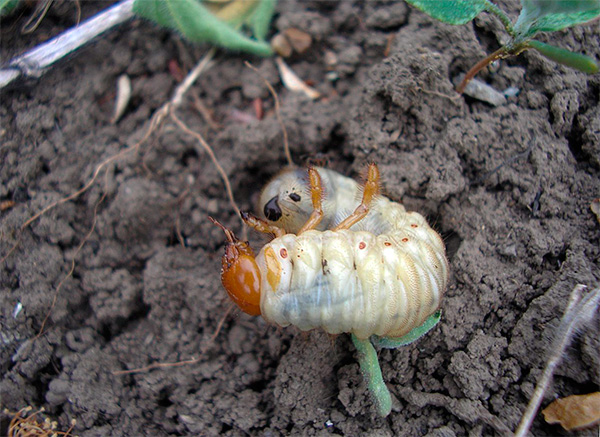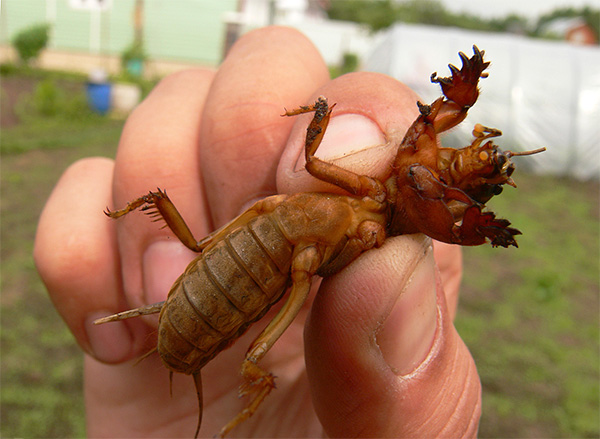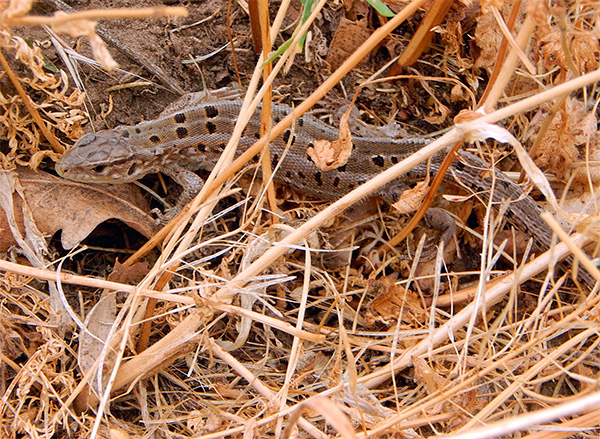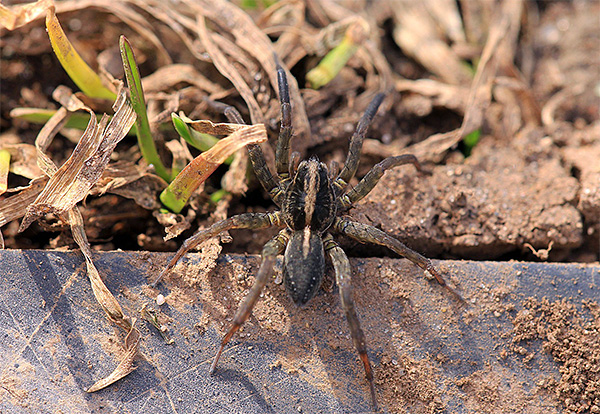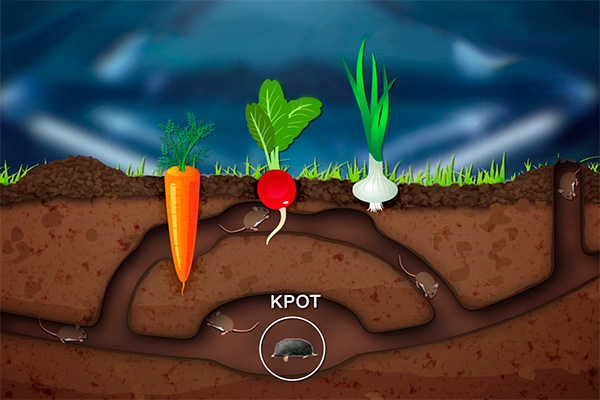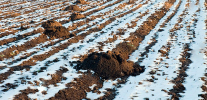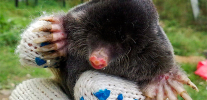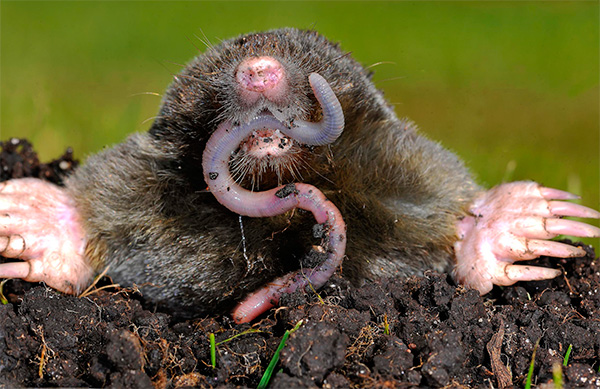
In many summer residents and gardeners, moles are associated only with the appearance of a large number of ugly heaps of land on carefully groomed beds, as well as with regular damage to various root crops - carrots, beets, potatoes, onions ... And if you ask, for example, an outdoor enthusiast, what eating a mole, many would say that it’s actually eating these vegetables and it doesn’t disdain carrots, potatoes, and sometimes garlic.
In general, everything that is somehow damaged during the life of these animals on the site is often attributed to the food addictions of moles.
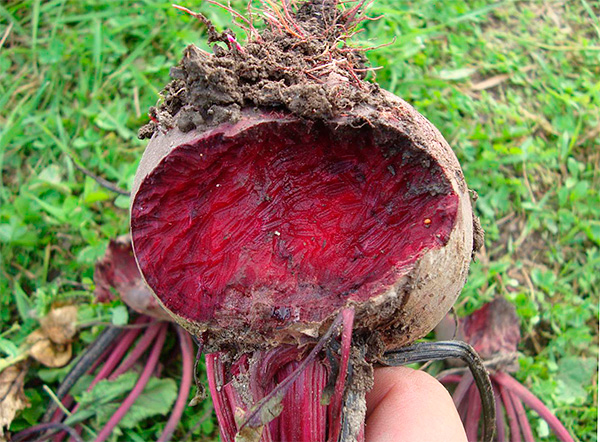
At the same time, even schoolchildren, new to garden art, are well aware that the mole is a predator, and it feeds mainly on insects and earthworms.
This is a definite contradiction associated with the idea of what moles eat: book and scientific theory says that moles feed on invertebrate animals, and gardening practices seem to show quite clearly that moles eat underground parts of plants.
What is the truth here? Everything falls into place if you understand not only what moles eat, but also how they do it ...
Mole's Favorite Food
Indeed, moles eat mainly invertebrate animals, with the largest part of their diet being earthworms. This is a fact proved by specially conducted studies: scientists caught animals with mole-crushers, carcasses were opened and then the contents of the stomachs were examined.
According to the results of such studies in the stomachs of moles were found:
- Earthworms - more than 90% of the contents, they were found in all captured animals;
- Beetle larvae - about 6% of the content;
- Other insects, millipedes and crustaceans (wood lice) - about 3%;
- The remains of grains and soft parts of plants, tubers and root crops - less than 1%.
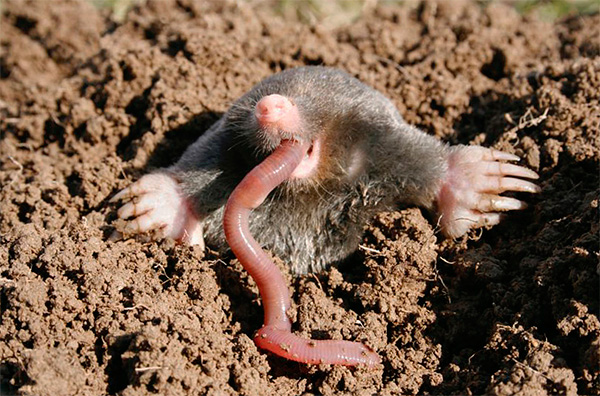
We conclude: moles eat mainly earthworms and insect larvae, and also slightly diversify this exquisite meat diet with coarser adult insects and various invertebrates, and rarely eat parts of plants.
In general, these studies only confirm other scientific evidence. For example, such:
- The structure of the teeth and the entire digestive system of the mole is fully consistent with the structure of the digestive system of a predatory animal. It has a relatively short intestine, sharp, well-developed fangs and incisors, but rather weak chewing teeth. In addition, the metabolism of the mole is very fast, which is typical just for animals that eat meat;
- The mole is the closest relative to predators such as the shrew, cutter and muskrat. It would be strange if a representative of the family, which includes some of the most voracious predators on Earth, turned out to be a vegetarian ...
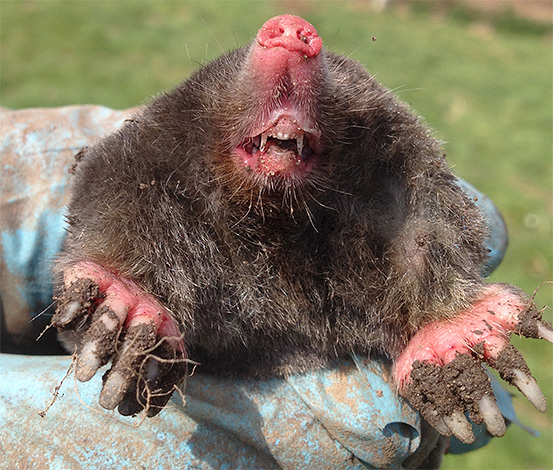
It is interesting
Indeed, the smallest predatory mammals on the planet are the most voracious, if we compare the weight of their bodies and the weight of the food they consume. For example, a shrew, weighing only 5-6 grams, consumes as much food per day as it weighs itself. If she was the size of a lion, she would need at least 100-150 kg of meat per day. Fortunately, biological laws prevent such voracious creatures from becoming large, and large predators from becoming so active eaters.
Simply put, a mole is the same shrew that has only almost completely switched to an underground way of life. But such a transition did not affect food preferences - moles feed on everything that their common ancestors ate with shrews.
Moreover, the mole eats mainly earthworms not so much because of their unique nutritional or taste qualities, but because of their abundance and abundance in the fertile layer of the earth. The animal is constantly moving in its underground tunnel, or digs a new one, and at the same time catches and immediately eats everything that comes in its way. An earthworm will come across - eat it, a slug or a centipede will come across - will also go "for a snack."
Of course, the food of a mole varies somewhat depending on which biotope it lives in and in what soil it burrows its burrows. For example:
- In the forest, the mole feeds on earthworms, but about a third of its diet in the warm season is also composed of large ants, wood lice and millipedes, accidentally creeping into its underground passages;

- In the meadow, moles also predominantly eat worms, but here larvae and adult insects (usually pests of plant roots): beetles and their fat white larvae, wireworms, butterfly caterpillars make up an important part of their diet. Since there are a lot of plant roots themselves in meadows, there are more of these pests than in the forest, and they get to the “mole's table” more often;

- On soils with a significant proportion of sand and clay (which, by the way, these animals do not like), moles are limited in nutrition. Here, a larva or bug is a rare treat, and as a result, almost the entire diet of the dungeon inhabitant consists of the ubiquitous earthworms.
On a note
The moles' hunting grounds can be located on the borders of different biotopes - part can be located under a tree grove, the other part - in a forest glade or under a field. The inhabitant of such a site can significantly diversify their nutrition, moving either under the roots of trees, then on oily, plowed and fertilized cultural soil.
However, the predatory nature of moles is far from limited to worms, insects and their larvae. Few people know that if a mole has a suitable opportunity, then he does not disdain practically anything that moves and consists of flesh ...
What else can enter the dungeon dweller's diet?
If a mole in its feed course discovers any living creature that is smaller in size and with which it is able to cope, it eats it.
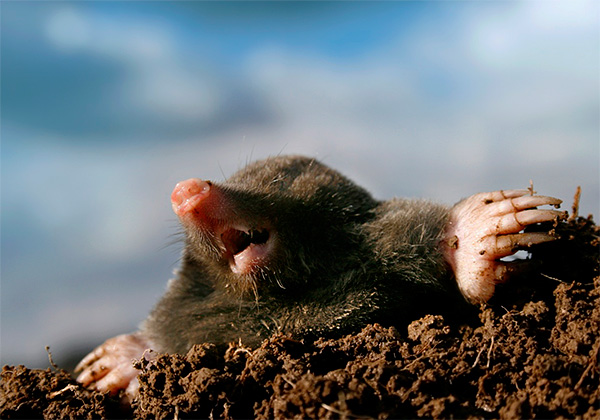
For example:
- The mole eats a bear - this is a large and therefore nutritious insect, which, moreover, is low-risk and not poisonous, serves as an excellent snack for the animal. Partly due to this, the mole is not such an unambiguous pest in vegetable gardens and summer cottages - sometimes the benefits of eating it with a bear exceed the damage it does to the beds;

- Moles even eat mice. Of course, they are not purposefully looking for them, but when, digging a new move, the mole “breaks” into the mouse nest with mice, then the fragile animals almost always serve as food for the insatiable predator. Moreover, even adult mice that run into the underground passages, the mole can eat, although this happens very rarely, because the mice are too nimble and have time to escape;

- Lizards, frogs, small toads and snakes also often become victims if they fall into mole passages and meet in them with the "owner of the dungeon";

- Moles also eat spiders, even large and poisonous ones such as tarantulas, but, again, much depends on the potential victim’s ability to quickly escape from the predator. The situation is similar with ants - the mole eats them in the course of its movement, not particularly lingering.

On a note
The feed passages of moles themselves are peculiar traps into which various victims of these animals often fall. They themselves crawl spiders and millipedes, earthworms protesting their moves, small mammals run in and lizards hide. One of the important tasks of moles is to regularly check dug moves, and if they suddenly stop “catching” the right amount of food, dig new “traps”.
In rare cases, moles can eat their brethren. These animals are very aggressive towards other individuals in their feed area, and when they meet, conflicts and fights occur, sometimes ending in the death of one of the animals. The winner does not show particular scrupulousness, and can quite easily eat a defeated opponent.
Accordingly, and in a collision with a shrew, smaller than himself, the mole will try to diversify its diet.

Thus, in nature, the mole feeds not only on insects or worms, but almost on everything that moves, and with what generous soil it will please it.
The various remains of plant food that are found in the stomachs of moles when opened, enter the animal’s diet only occasionally, often by accident - during continuous digging of underground passages and eating worms and insects among the roots of plants. In general, plant food is not significant for the animal.
What does a mole eat in winter?
First of all, it is worth noting that moles do not hibernate in winter, continuing to dig underground passages and eat actively.

In winter, the mole eats everything that it eats in the summer, but adjusted for a change in the proportion of the corresponding food objects in the soil. For example, in summer, beetles and ants are found in large numbers in the land, and practically none can be found in winter (beetles die mostly in the autumn, only larvae remain in the ground; and in the winter, ants practically do not move beyond the anthill) .
In the winter time of the year, mole pupae and butterflies, shallow wasps, hornets and some other insects wintering in shallow mole can come across in the soil - all this also forms part of the animal’s winter diet. Nevertheless, moles do not change their habits with the onset of cold weather, and continue to consume mainly earthworms. Fortunately, this food from the soil does not disappear anywhere (in winter, earthworms dig deeper and fall into suspended animation).
In addition, in winter, moles also feed on worms, stored since the summer and in abundance “stored” in various sections of the underground passages. The animal bites off the front half of the body (the "head") of the worm and eats it right away. The back of the body, unlike the front, is not capable of regeneration, and dies quite quickly, remaining a kind of "canned food in reserve".
It is interesting
The idea that if you cut an earthworm in half, then two completely viable halves appear, is deeply erroneous. Only the front half is capable of regeneration, and the rear half always dies.

Sometimes the mole paralyzes the worm, biting through the nerve node - as a result, the worm does not die immediately, but cannot crawl away, just lying in the aft course and waiting for the hungry animal to stumble upon it again and enjoy quite fresh meat.
Researchers found up to several hundred worms in different mole burrows.
On a note
The mole makes its reserves for the winter with an excess of worms in the summer, when when moving along the moves it constantly encounters them, but due to overeating it can no longer eat immediately. In this case, the mole, almost without stopping, bites the worm's body strictly in the right place and continues on its way. And in the winter, checking its moves, the animal encounters such canned food and eats them. A mole can also store worms in special compartments of its system of moves.
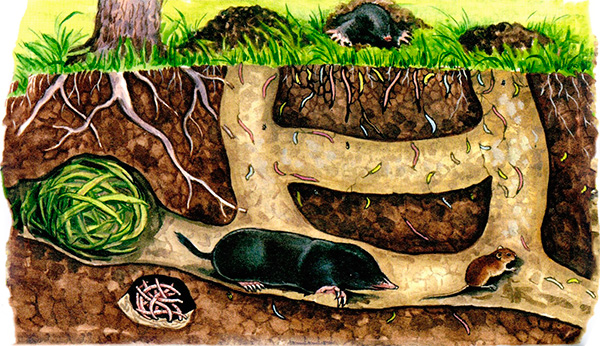
In addition, in winter, molehills and mice often appear in mole moves, which at this time of the year are much more difficult (and sometimes even impossible) to move under or through snow. Once in the tunnel, the animal tries to find here either an insect (if it is a shrew), or roots and tubers (if it is a mouse), and may encounter a mole ...
Note that everywhere where the mole lives, in winter and early spring, there is a significant mortality of these animals precisely from non-feed.Due to its very fast metabolism, the insectivorous animal cannot remain hungry for more than a day, and in winter it is often that it does not find anything nutritious in a day.


A little about the "culture" of the food of the mole: when, how and how much does it eat?
The mole eats a lot and often. For a day he eats about 5-8 times, crawling out of the nesting chamber, in which he rests, and for a very long time collecting food in the feed passages.
Between meals, the animal rests and sometimes sleeps.
On a note
The digestion of a serving of food takes about 4-5 hours in a mole. After this time, the animal becomes hungry again, and after 16-17 hours, if it does not find food, it weakens and dies quickly from starvation. Thus, the mole must literally constantly eat.
In one sitting, the mole eats about 15-20 grams of feed, and in a day - about 50-60 grams. As a rule, a day he needs an amount of food, comprising 60-70% of his body weight, although in hungry times he can "get out" and 20-30%. And in the "fat" summer days, walking the mass, the animal can eat as much as he weighs.
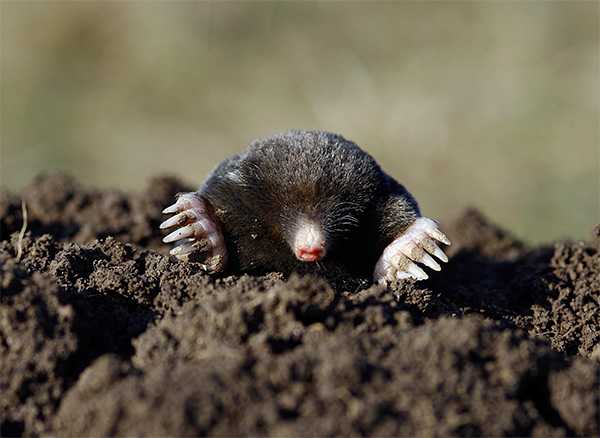
It may seem that the mole eats a lot (if a person consumed the same amount of food in relation to his weight, he would have to eat 40-50 kilograms of meat per day). Such gluttony of animals looks fantastic, but from a scientific point of view it is quite easy to explain:
- Moles have a very fast metabolism. So, the consumed food turns into energy or fat reserves in their body in a few hours. After this, the animal needs to eat again;
- Moles are very active and spend a lot of energy. Only the one who did not see them would think that these are clumsy, slow animals. In fact, the mole is very fast, and if it does not sleep, it is constantly in motion, which means it constantly spends energy that needs to be restored;
- In search of food, the mole performs a large amount, so to speak, of hard work. Figuratively speaking, his energy investments in the search for feed are very large, and in order to at least “repulse” them, he needs to eat a lot. To understand this statement, imagine that in order to get a serving of food, you need to dig a stroke in the ground with a diameter equal to the width of the shoulders and a length of about a meter. Also imagine how much energy you will spend on it and what a portion of food should be in order to at least restore strength after such labor;
- Due to the small size of the body of the mole, the heat transfer in relation to its mass is significantly higher than that of larger animals. So, constantly being in the cold earth, the animal needs more food to maintain body temperature than, say, a person or a dog.
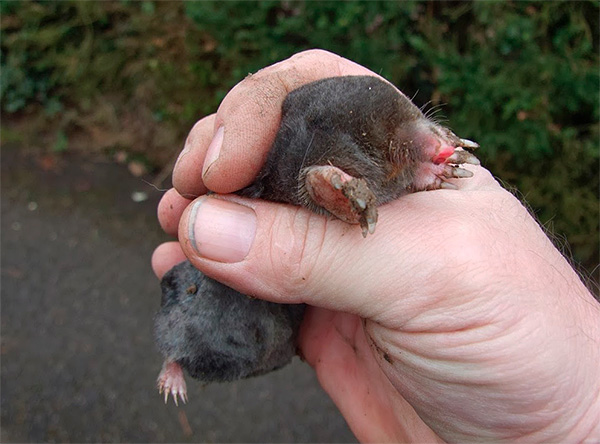
When feeding, the mole sometimes simply moves along the course, picking up its victims in it, and when saturated, it moves to the residential passage and rests there. If necessary, the animal begins to dig new moves.
In winter, the mole needs slightly less food than in the summer, due to which it can survive in conditions of reduced amount of food.
Moles have no pronounced fluctuations in daily feed activity. Is that at night, animals often dig new moves and get to the surface, so at night they consume less food. But in general, these animals eat and rest approximately evenly throughout the day.
Does the mole eat carrots, potatoes and other root vegetables?
There is a myth that moles love to eat root crops in garden plots, for which they are very disliked, the gardeners themselves are harassing and destroying. In fact, moles do not eat potatoes, nor carrots, nor, especially, garlic. And the myth itself is due to the following reasons:
- When laying the course, the mole, as they say, “breaks through” - under its powerful claws, carrots, potato tubers, and onions crumble. In the same place where the animal wants to get to the surface, he breaks the bed and either throws the root of the plant to the surface, or the same root falls into a dug tunnel.Of course, this mole spoils the planting, and the inexperienced gardener gives the impression that the animal is just eating its crop;
- Moleholes are actively used by mice and field voles, precisely in order to get to juicy root crops. Gardeners rarely see animals themselves, but they well notice that along the molehill all tubers are beaten and bitten. The thoughts of man are easily readable;

- In the south of the country, in the zone of steppes and semi-deserts, rodents are harmful to gardens, leading an underground lifestyle - mole rats, mole rats, mole rats, and some of their relatives. They really feed on roots. The gardeners, not really understanding who dug the underground passages, attribute everything to real moles.
Moreover, in vegetable gardens and cultivated lands, moles feed on what they usually like to eat in the forest or in meadows - that is, not at all potatoes or carrots.
Mole feeding in vegetable gardens and summer cottages
Along with the fact that the mole is harmful, in gardens and orchards, it also benefits because it eats a bear, wireworm, larvae of May beetles and slugs. Ants, which gardeners often try unsuccessfully to fight, also get from moles - animals can very effectively inhibit the growth of anthills.
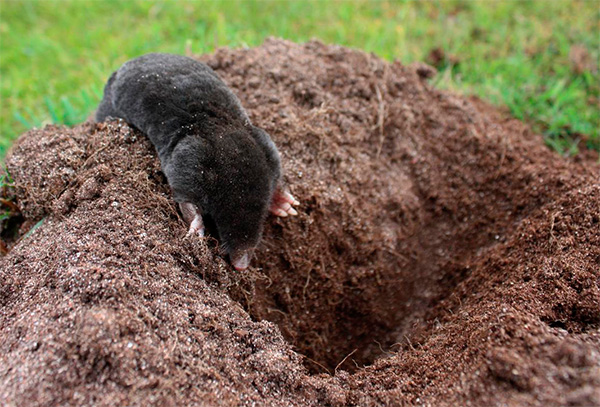
And yet, the basis of the diet of moles in summer cottages and gardens is earthworms. Again, not because animals love them very much, but because there are more of these worms on generously fertilized manure and constantly loosened beds than other invertebrates, and they most often come across animals when checking hunting moves.
Given that earthworms themselves are useful for the garden, eating them, moles cause additional damage. And, as studies show, the harm of an animal exceeds the benefit that it brings in a summer cottage or in a separate garden.
And who eats moles?
In turn, moles often themselves become victims of other predators. They are actively hunted by birds of prey (moons, buzzards, eagles, owls), as well as foxes, wolves and dogs, martens. Even weasels eat young individuals, which actively climb into moleholes in search of hosts.
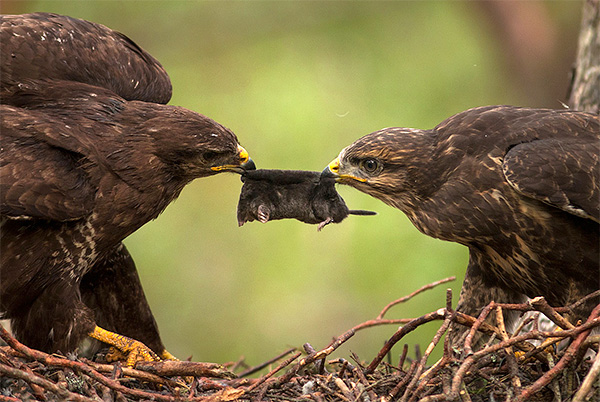
At the same time, some predators eat moles only in the famine, since the animals smell strongly of musk and do not differ in pleasant taste. This is partly why moles are not eaten in any kitchen in the world, even in China, where, it would seem, they can cook kebabs from anything.
In nature, animals and birds that feed on moles can catch the animal, kill, but, having felt the smell and not being hungry, leave them at the place of capture. This often happens with shrews that have an even more unpleasant odor.
Interesting video: the mole catches and eats first a lizard, and then a frog
The mole does not sleep in the winter, actively moving under the snow ...

